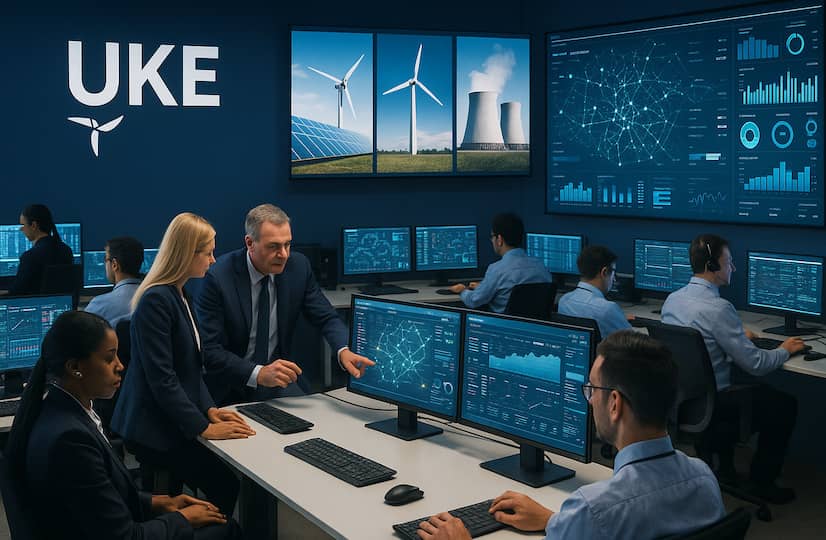
Energy Efficiency: Can the UK Modernise Government and Create UK Energy?
Introduction: Britain's Energy Crossroads
The United Kingdom stands at a historic crossroads in its energy journey. After decades of market-driven policies, privatisation, and foreign ownership, Britain's energy sector is failing the public. Families are facing the highest energy bills in living memory. The cost-of-living crisis is compounded by a broken energy market, volatile global gas prices, and outdated infrastructure.
The need for a clean, affordable, and secure energy future has never been greater. Yet the private sector has failed to deliver it.
At the heart of The Modern Party's vision is UK Energy (UKE) — a modern, efficient, publicly owned energy system designed for the 21st century. Powered by AI-driven efficiency, skilled British workers, and a balance of renewables and nuclear energy, UKE will not repeat the failures of the 1970s but will embrace the technologies, skills, and accountability needed to deliver energy security, taxpayer value, and climate action.
This article outlines how government efficiency has evolved since the 1970s, how AI and a skilled workforce can transform public energy, and why The Modern Party’s plan to build 10 APR-1400 nuclear reactors will anchor a clean energy future for Britain.
The 1970s: Lessons from the Past
Opponents of public ownership often point to the UK's nationalised energy sector of the 1970s as a cautionary tale. Back then, energy was managed by bureaucratic entities like the Central Electricity Generating Board (CEGB). It was an era plagued by inefficiency, industrial disputes, and crises like the Three-Day Week in 1974, when coal shortages and strikes forced the country into energy rationing.
While the CEGB ensured coordinated national planning and energy supply, it lacked transparency, consumer focus, and innovation. It was a top-heavy bureaucracy designed for a command-and-control economy, not for flexibility, accountability, or technological progress.
These failures led to a rush toward privatisation in the 1980s and 90s. Yet privatisation simply replaced public inefficiency with private profiteering. Today, British consumers pay among the highest electricity prices in Europe, with 95% of UK energy firm shares owned by foreign investors, extracting profits while British families foot the bill.
The lesson is clear: We can't return to the 1970s model. But neither can we continue the failing status quo of market chaos.
Government Efficiency in the Modern Era: The UKE Model
The public sector today is unrecognisable from the 1970s. Across the world, modern public enterprises use data, digital tools, and AI to streamline services, cut costs, and deliver excellent outcomes. In transport, healthcare, and energy, state-owned companies from Norway to Singapore show that government ownership can be efficient, innovative, and customer-focused.
The Modern Party’s proposed UK Energy (UKE) would reflect this 21st-century model:
• Lean, transparent, and accountable.
• Driven by performance metrics and customer satisfaction.
• Empowered by AI, predictive analytics, and automation to cut waste.
• A bottom-heavy, skilled workforce focused on delivery, not bloated management.
Rather than a top-down monolith, UKE will be a digitally savvy, data-driven enterprise, using real-time insights to optimise the grid, balance renewable variability, and prevent costly outages. Citizens would own UKE — but it would be run to world-class commercial and efficiency standards, benchmarked against global leaders.
AI and Technology: The Engine of Efficient Public Energy
At the core of UKE’s efficiency model will be artificial intelligence (AI) and advanced analytics.
Unlike the 1970s, today’s technology allows AI to manage entire energy grids in real-time, predicting demand surges, managing distributed renewables, and automating maintenance scheduling.
According to research, AI-driven forecasting can improve wind and solar output predictions by 30%–35%, reducing the need for expensive backup power and cutting costs for consumers.
AI also allows for predictive maintenance, anticipating failures before they occur, preventing outages, and slashing repair costs by up to 30%, as seen in sectors from aviation to utilities.
Under UKE, AI will be embedded in every process, from billing to grid management, customer service to infrastructure planning. This will enable lower operational costs, greater transparency, and faster decision-making — efficiencies the 1970s bureaucracy could only dream of.
Moreover, with AI integrated into energy management, UKE can cut unnecessary middle management, ensuring more investment goes into frontline services and workforce skills, not bureaucratic layers.
Upskilling the Workforce: The Heart of UKE’s Success
If AI is the brain of UKE, the workforce is its heart.
Britain cannot achieve a clean energy transition or nuclear revival without a highly skilled, modern workforce. Unfortunately, decades of underinvestment have left the UK lagging behind global competitors in engineering, construction, and nuclear skills.
In contrast, countries like South Korea and China have shown the power of government-led skills planning. South Korea's success with its APR-1400 nuclear program is not just about technology; it's about building a pipeline of domestic engineers, technicians, and scientists, ensuring jobs, skills, and manufacturing stay at home.
Similarly, China’s state-owned energy giants have trained millions of skilled workers to deliver the world’s largest clean energy buildout.
The Modern Party would establish a National Skills Academy for Energy under UKE, modelled on South Korea’s approach, offering:
• Vocational training for energy infrastructure, nuclear operations, and renewables.
• Apprenticeships and university partnerships to train the next generation of engineers and AI specialists.
• Retraining programs for fossil fuel workers to transition into clean energy roles.
This workforce investment will not only support UKE’s success but will create tens of thousands of well-paid, future-proof British jobs, revitalising communities from Teesside to Wales.
Building 10 APR-1400 Nuclear Reactors: Anchoring Skills, Security, and Stability
Nuclear energy is the bedrock of any secure, clean, and reliable power system. The Modern Party proposes building 10 APR-1400 nuclear reactors in the UK, creating 14 GW of firm, zero-carbon power — equivalent to 35%–40% of the UK’s electricity needs.
These reactors will:
• Deliver reliable, weather-proof electricity, balancing intermittent renewables.
• Create tens of thousands of skilled construction and operations jobs.
• Anchor a domestic supply chain of steel, engineering, and manufacturing.
• Ensure energy independence from volatile global gas markets.
• Cut CO2 emissions by up to 60 million tonnes annually.
Crucially, building these reactors using a standardised design (APR-1400) will slash costs, avoiding the endless delays and overspends of bespoke UK projects like Hinkley Point C.
South Korea builds APR-1400 reactors for around £2,200 per kW — a fraction of the £10,000 per kW seen in the UK today. By adopting a repeatable model and upskilling the British workforce, UKE can deliver nuclear power faster, cheaper, and with more UK jobs.
The Modern Party’s 5-Step Plan to Deliver UK Energy (UKE)
To realise this vision, The Modern Party proposes a clear, actionable 5-step plan:
1. Create UK Energy (UKE): A Modern, Publicly Owned Energy Enterprise
Establish UKE as a lean, AI-powered, publicly owned company, responsible for generation, grid, and supply — cutting out profiteering middlemen and putting energy back under public control.
2. Balance Renewables and Nuclear for a Reliable, Low-Carbon Grid
Invest in 50 GW of renewables by 2030 alongside 10 APR-1400 reactors, ensuring clean energy security without reliance on gas imports.
3. Launch a National Skills Academy for Energy
Train the next generation of nuclear engineers, grid managers, and AI specialists, modelled on South Korea’s success, with apprenticeships, university partnerships, and retraining programs.
4. Embed AI and Predictive Technologies Across UKE
Use AI to optimise grid management, reduce downtime, predict maintenance, and automate billing, saving billions in operational costs and improving customer service.
5. Guarantee Savings for British Taxpayers
Cut costs by eliminating shareholder dividends, reducing debt costs through public borrowing, and using AI and skills efficiency to pass £300+ annual savings per household back to British families.
Conclusion: A Clean, Secure, and Affordable Energy Future for All
Britain cannot solve its energy crisis with the failed models of the past — nor can it rely on the private market to fix itself. The future demands bold leadership, modern technology, and a public energy system fit for the 21st century.
The Modern Party’s UK Energy (UKE) will be that system: efficient, accountable, AI-powered, and worker-driven. It will combine the best of public ownership with the agility of the digital age, ensuring affordable, secure, and clean energy for every British home and business.
By upskilling our workforce, building standardised nuclear plants, embracing AI, and cutting wasteful bureaucracy, UKE will create tens of thousands of jobs, slash emissions, protect consumers, and restore pride in British industry.
The choice is clear: stick with the outdated, profiteering model, or embrace a bold, people-first, clean energy future.
The Modern Party invites every citizen to join us in building UK Energy (UKE) — for Britain, for the planet, for the future.
